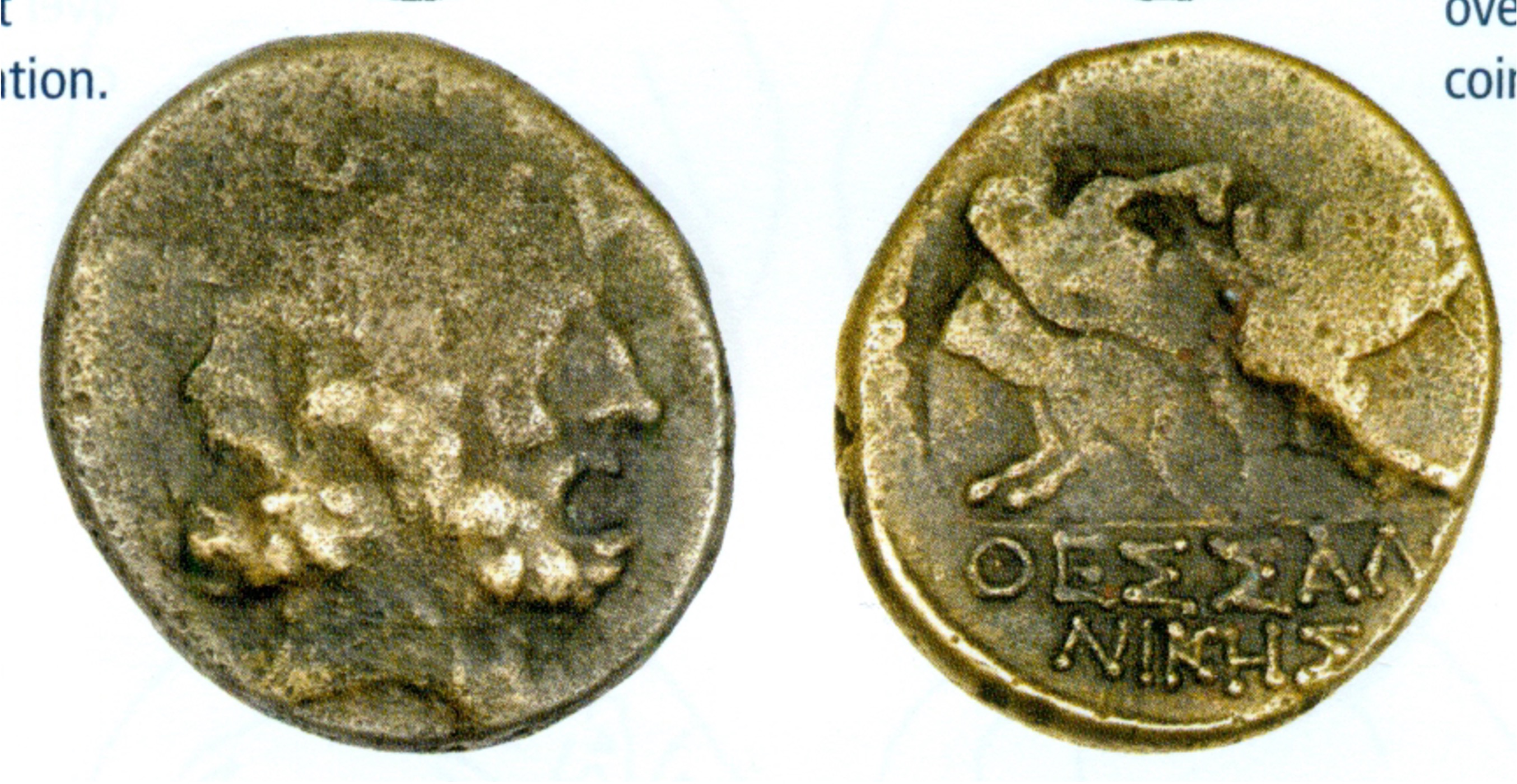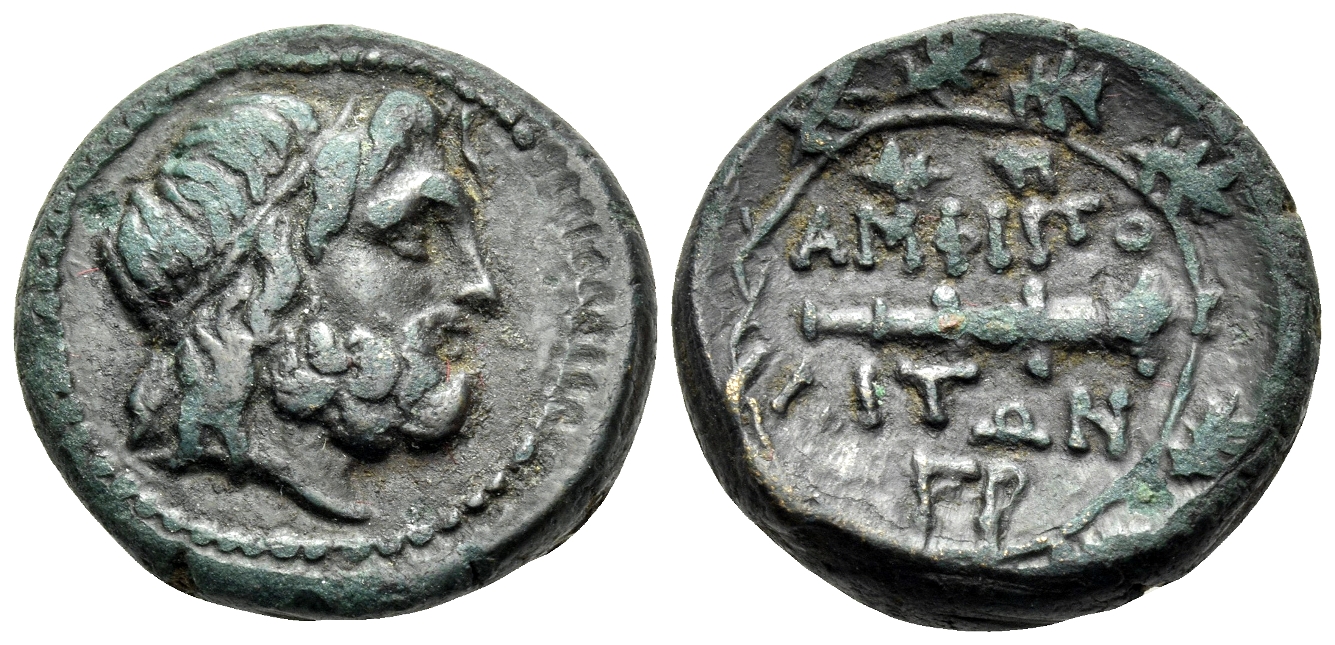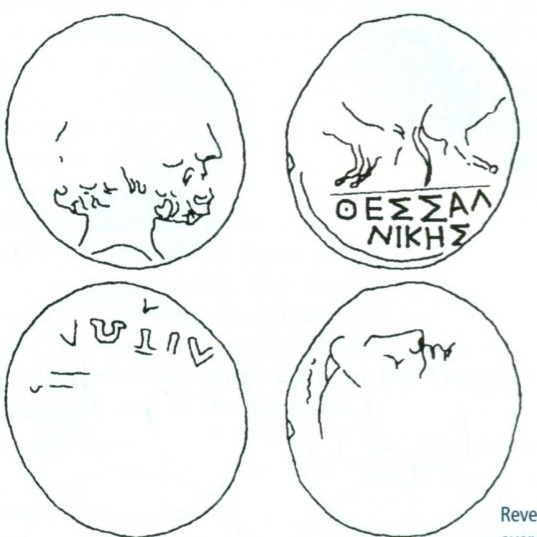100 BCE - 75 BCE | ΘΕΣΣΑΛΟΝΙΚΗΣ
Overstriking coin
SO 746 - Thessalonica over Amphipolis.jpg
Overstruck variety
746 1 Amphipolis.jpeg
[1]
746 - Thessalonica over Amphipolis (drawing).jpg
Description
| ObverseInscription or printing placed on the obverse.:
|
Head of Janus, wearing laurel wreath. Above, I (value mark).
|
ReverseInscription or printing placed on the reverse.:
|
ΘΕΣΣΑΛΟΝΙΚΗΣ (Greek) Two centaurs rearing, facing away from one another, holding branches.
|
Mint and issuing power
| MintIdentifies the place of manufacture or issue of a numismatic object.:
|
Thessalonica
|
Ancient regionAncient region.
|
Macedon
|
Modern countryModern country: Greece
|
AuthorityIdentifies the issuing power. The authority can be "pretended" when the name or the portrait of X is on the coin but he/she was not the issuing power. It can also be "uncertain" when there is no mention of X on the coin but he/she was the issuing power according to the historical sources:
|
Roman Republic, Roman province of Macedonia
|
Chronology
| FromIdentifies the initial date in a range assigned in a numismatic context. 100 BCE toIdentifies the final date in a range assigned in a numismatic context.. 75 BCE
|
Hellenistic 323-30 BC  periodTime period of the numismatic object. periodTime period of the numismatic object.
|
Physical description
MetalThe physical material (usually metal) from which an object is made.: Bronze 
|
WeightWeight of the numismatic object (in grams). in grams: 6.936.93 g <br />6,930 mg <br />
|
DenominationTerm indicating the value of a numismatic object. Examples: tetradrachm, chalkous, denarius.: as 
|
AxisDescribes the directional relationship between the obverse and reverse of a numismatic object.: 1212 mm <br />1.2 cm <br />
|
| DiameterDescribes diameter of an object (in mm).: 2121 mm <br />2.1 cm <br />
|
StandardStandard.: Semuncial
|
References
| Coin referenceReference of the Coin:
|
MacDonald 2000, p. 119, n° 2, MacDonald 2009, p. 83, n° 62
|
Coin series referenceReference to coin series study:
|
Gaebler 19351Gaebler 1935, p. 120-121, n° 19, MacDonald 20002MacDonald 2000, p. 119, n° 2, MacDonald 20093MacDonald 2009, p. 83, n° 62, HGC 3.14HGC 3.1, n° 741, Kourempanas 20165Kourempanas 2016, n° 17
|
| Coin series web referenceCoin series web references:
|
|
Description
| ObverseInscription or printing placed on the obverse.:
|
Head of Poseidon right, wearing diadem or wreath (visible: profile of Poseidon from top of head to beard, details of eye).
|
ReverseInscription or printing placed on the reverse.:
|
(ΑΜΦΙΠΟ)ΛΙΤΩΝ (Greek) Club and monograms within wreath (visible: traces of wreath and club).
|
Mint and issuing power
Chronology
| FromIdentifies the initial date in a range assigned in a numismatic context. 148 BCE toIdentifies the final date in a range assigned in a numismatic context.. 88 BCE
|
Hellenistic 323-30 BC  periodTime period of the numismatic object. periodTime period of the numismatic object.
|
Physical description
References
References
- a b Gaebler, Hugo (1935), Die antiken Münzen Nord-Griechenlands, unter Leitung von Theodor Wiegand. Band III, Makedonia und Paionia. 2. Abt., Verlag W. de Gruyter, Berlin
- ^ MacDonald, David (2000), "Macedonian civic bronze overstrikes and circulation areas," Nomismatika chronika 19, p. 115-121
- ^ Macdonald, David (2009), Overstruck Greek coins: studies in Greek chronology and monetary theory, Whitman Publishing, Atlanta.
- ^ Hoover, Oliver D. (2016), Handbook of coins of Macedon and its neighbors. 3. Part I: Macedon, Illyria, and Epeiros, sixth to first centuries BC, Lancaster, 437 p.
- ^ Kourempanas, Theodoros (2016), "Τα ελληνιστικά νομίσματα της Θεσσαλονίκης" , Athens, p. 112, pl. 13.
 Traces of the overstruck variety
Traces of the overstruck variety

